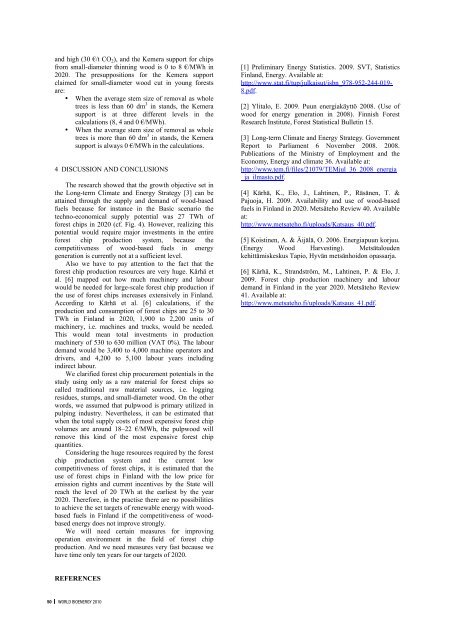Proceedings World Bioenergy 2010
Proceedings World Bioenergy 2010
Proceedings World Bioenergy 2010
Create successful ePaper yourself
Turn your PDF publications into a flip-book with our unique Google optimized e-Paper software.
and high (30 €/t CO 2), and the Kemera support for chips<br />
from small-diameter thinning wood is 0 to 8 €/MWh in<br />
2020. The presuppositions for the Kemera support<br />
claimed for small-diameter wood cut in young forests<br />
are:<br />
• When the average stem size of removal as whole<br />
trees is less than 60 dm 3 in stands, the Kemera<br />
support is at three different levels in the<br />
calculations (8, 4 and 0 €/MWh).<br />
• When the average stem size of removal as whole<br />
trees is more than 60 dm 3 in stands, the Kemera<br />
support is always 0 €/MWh in the calculations.<br />
4 DISCUSSION AND CONCLUSIONS<br />
The research showed that the growth objective set in<br />
the Long-term Climate and Energy Strategy [3] can be<br />
attained through the supply and demand of wood-based<br />
fuels because for instance in the Basic scenario the<br />
techno-economical supply potential was 27 TWh of<br />
forest chips in 2020 (cf. Fig. 4). However, realizing this<br />
potential would require major investments in the entire<br />
forest chip production system, because the<br />
competitiveness of wood-based fuels in energy<br />
generation is currently not at a sufficient level.<br />
Also we have to pay attention to the fact that the<br />
forest chip production resources are very huge. Kärhä et<br />
al. [6] mapped out how much machinery and labour<br />
would be needed for large-scale forest chip production if<br />
the use of forest chips increases extensively in Finland.<br />
According to Kärhä et al. [6] calculations, if the<br />
production and consumption of forest chips are 25 to 30<br />
TWh in Finland in 2020, 1,900 to 2,200 units of<br />
machinery, i.e. machines and trucks, would be needed.<br />
This would mean total investments in production<br />
machinery of 530 to 630 million (VAT 0%). The labour<br />
demand would be 3,400 to 4,000 machine operators and<br />
drivers, and 4,200 to 5,100 labour years including<br />
indirect labour.<br />
We clarified forest chip procurement potentials in the<br />
study using only as a raw material for forest chips so<br />
called traditional raw material sources, i.e. logging<br />
residues, stumps, and small-diameter wood. On the other<br />
words, we assumed that pulpwood is primary utilized in<br />
pulping industry. Nevertheless, it can be estimated that<br />
when the total supply costs of most expensive forest chip<br />
volumes are around 18–22 €/MWh, the pulpwood will<br />
remove this kind of the most expensive forest chip<br />
quantities.<br />
Considering the huge resources required by the forest<br />
chip production system and the current low<br />
competitiveness of forest chips, it is estimated that the<br />
use of forest chips in Finland with the low price for<br />
emission rights and current incentives by the State will<br />
reach the level of 20 TWh at the earliest by the year<br />
2020. Therefore, in the practise there are no possibilities<br />
to achieve the set targets of renewable energy with woodbased<br />
fuels in Finland if the competitiveness of woodbased<br />
energy does not improve strongly.<br />
We will need certain measures for improving<br />
operation environment in the field of forest chip<br />
production. And we need measures very fast because we<br />
have time only ten years for our targets of 2020.<br />
REFERENCES<br />
50 world bioenergy <strong>2010</strong><br />
[1] Preliminary Energy Statistics. 2009. SVT, Statistics<br />
Finland, Energy. Available at:<br />
http://www.stat.fi/tup/julkaisut/isbn_978-952-244-019-<br />
8.pdf.<br />
[2] Ylitalo, E. 2009. Puun energiakäyttö 2008. (Use of<br />
wood for energy generation in 2008). Finnish Forest<br />
Research Institute, Forest Statistical Bulletin 15.<br />
[3] Long-term Climate and Energy Strategy. Government<br />
Report to Parliament 6 November 2008. 2008.<br />
Publications of the Ministry of Employment and the<br />
Economy, Energy and climate 36. Available at:<br />
http://www.tem.fi/files/21079/TEMjul_36_2008_energia<br />
_ja_ilmasto.pdf.<br />
[4] Kärhä, K., Elo, J., Lahtinen, P., Räsänen, T. &<br />
Pajuoja, H. 2009. Availability and use of wood-based<br />
fuels in Finland in 2020. Metsäteho Review 40. Available<br />
at:<br />
http://www.metsateho.fi/uploads/Katsaus_40.pdf.<br />
[5] Koistinen, A. & Äijälä, O. 2006. Energiapuun korjuu.<br />
(Energy Wood Harvesting). Metsätalouden<br />
kehittämiskeskus Tapio, Hyvän metsänhoidon opassarja.<br />
[6] Kärhä, K., Strandström, M., Lahtinen, P. & Elo, J.<br />
2009. Forest chip production machinery and labour<br />
demand in Finland in the year 2020. Metsäteho Review<br />
41. Available at:<br />
http://www.metsateho.fi/uploads/Katsaus_41.pdf.









